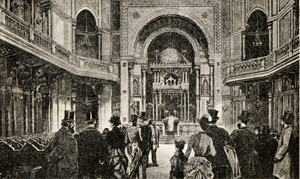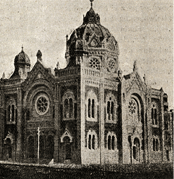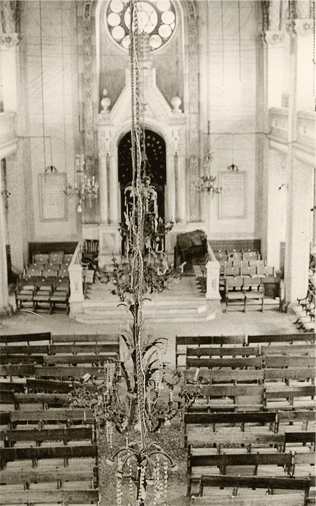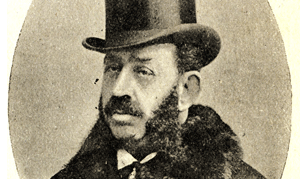The Turkish-Jewish Community and the Synagogue in Vienna
- Written by Admin TOA
- Published in Interesting Facts

By Naim “Avigdor” Güleryüz* – Researcher
On November 16, 1885 in Vienna, during the ceremony for the establishment of a new synagogue in the Zirkusgasse Second District, No.22, the president of the Sefarad, Vienna Jew Marcos Russo spoke to the invitees as follows: “When his majesty Franz-Josef is the emperor of Austria and his majesty Sultan Abdulhamid II is the emperor of the Ottoman Empire, when Sadullah Pasha is the ambassador of Ottoman Empire in Vienna and Marcos Russo is the president of the Turkish-Jewish community…the construction of this building is started in order to meet the religious need of the Jews of Sefarad…”
This synagogue, which had Turkish and Austrian flags swaying by its door, was officially opened on Sunday, September 17, 1887, at 7pm, and, during the opening ceremony, prayers in Judeo-Spanish were read, followed by the prayer (Anoten), on behalf of Franz-Josef I and Abdulhamid II and for the permanence and success of the country and the head of state; then the Austrian and Turkish national anthems were played.
The Sefarad synagogue, which had large pictures of the two rulers in its central hall, was a temple Ashkenazis continuously visited with pleasure for years and enjoyed its wonderful music, which was modernized without the changing of its authentic Eastern-Spanish melodies, and its excellence in religious services. After the establishment of the Turkish Republic, the aforementioned pictures were removed and replaced by large mirrors.
Architect Ritter von Weidenfeld designed this building in maghrebi design, inspired by the architecture of the Granada Elhamra Palace; there were 314 seats for men and 100 for women and, additionally, there was a space for 500 people to stand. The birthday of Sultan Abdulhamid II used to be celebrated in this synagogue, every year, through a special ceremony. The ceremony, which would be attended by a senior official from the Foreign Ministry and a high-ranking general from the War Ministry representing the Austrian government, and by the Turkish Ambassador and senior embassy officials dressed in their uniforms, used to be remembered as the ‘Sultanfeirn’, the Festival of the Sultan.

Since Austria and the Ottoman Empire were aligned on the same side during WWI, Austrian and Turkish flags continued to fly together at the door of this synagogue throughout this time.
With the start of new racist movements around 1925, the Jews of Sefarad began to leave Vienna gradually. The 800th birthday ceremony of the great intellectual Maimonides (Musa bin Meymun), in 1935, is remembered to be the last magnificent event to take place in the synagogue.
NIGHT OF BROKEN GLASS
On Kristallnacht, November 9-10, 1938 (November 9-10, 1938 is remembered as the ‘night of broken glass’ as hundreds of synagogues were destroyed and burned down in Germany and Austria by the Nazis), the Sefarad Synagogue also shared the fate of all other German and Austrian synagogues. It was burned down and destroyed.
So, why is there such an interest in the Ottomans, in their rulers, in their flag and their national anthem in Vienna, although the Ottomans never ruled there and, actually, Vienna had, twice, faced attempted invasions, by Suleiman the Magnificent (1529) and Merzifonlu Kara Mustafa Pasha (1683), who were both turned away from the doors of the city? Now we should go back to the very beginning of the story, to the time when the Inquisition still was in power in Spain during the 18th century.

According to the tale, a child named Mose Lopez Perera, in Madrid, is taken away from his family and is converted to Christianity. His name is changed to Diego d’Aguilar and he is trained as a priest. Diego, who speedily progresses in his education, becomes one of the passionate defenders of Inquisition and becomes a bishop. Mose Lopez’s mother and his sister are Marranos, converted Jews who secretly continue practicing their faith. His sister is caught as a result of denunciation, tried, and sentenced to be burned alive (Auto de Fe). One day before the execution, the hopeless and sorrowful mother visits Bishop Diego d’Aguilar and begs for the forgiveness of her daughter. However, the bishop rejects this request. In despair, the mother tells the Bishop the truth, that she is his mother, the convicted is his sister, and that his real name is Mose Lopez. This name instills many memories from childhood in the mind of the young priest. Sobbing greatly, the bishop leaves the palace running; however, it is already too late. His sister has lost her life in a tragic way. As he has taken off and thrown away his bishop’s clothes, Diego –or Mose -- can not stay in the country any longer. Escaping from there, he goes to Austria, where Maria-Teresa, who, as Archduchess, had given a golden chain to him during her visit to Madrid with her father Emperor Charles VI, is now reigning as Empress. The Empress allows Mose and a few more Jewish people that were able to escape with him to stay in and take refuge in her country and to practice their religion freely.
ACCORDING TO THE ENCYLOPEDIA JUDAICA
The plot of this story is different in the Encyclopedia Judaica and in historical research. According to the Encyclopedia, Mose Lopez Pereira was born in 1699 in Portugal as the son of a ‘Marrano’ banker. The father, Pereira, was privileged to hold the monopoly in the tobacco business. As it was difficult to secretly live as a Jew (this is referred to as being a ‘Marrano’) in Portugal, Diego first migrated to London in 1722, and, then, to Vienna. Renouncing Christianity, Diego returned to practicing Judaism and using his birth name, Mose (Moses) Lopez Pereira.
From 1723 to 1739, Mose Lopez had control of the Austrian State Tobacco Monopoly, acquired by the exchange of 7 million florins, and he received the title of Baron in 1726. Meanwhile, he contributed to the construction of the Schönbrunn Palace in the amount of 300,000 florins. Appointed to the Palace as a specialist consultant with the title of Hofjude (Jew in the Palace), Lopez used his influence not only in Austria but also in other countries in order to protect the lives and rights of his fellow coreligionists. He helped the Jews in Moravia in 1742, in Prague in 1744, in Mandua and Belgrade in 1752. There are Hebrew writings, which reads ‘Mose Lopez Pereire – 5498’ (1737-1738), on the decorations of a silver Sefer Torah crown that was found in the Vienna Synagogue. Until it was destroyed in 1938, prayers were read in the synagogue on behalf of him, as the founder of the community, on the major fasting day of Yom Kippur.
Around the same time, several Spanish families, such as the Kamondo, Nisan, and Eskenazy families, began to settle in Vienna. Mose Lopez, his wife, Samuel Oppenheimer, and his nephew Samson Wertheimer organized the Jews in Sefarad and establisedh the first Sefarad Community in Vienna in 1736. The Jews of Sefarad, who mostly had Ottoman roots, were living in much better conditions, compared to other Austrian Jews, under the item in Pasarofca Treaty which allowed free residency and trade for those in business with Ottoman tobacco industry, and they used to conduct their worship in the building, inside the Ring walls, on lot number 307, which they used as a synagogue.

SEFARAD IN VIENNA
However, this tranquility and peace did not last long. Mose Lopez learned about the empire’s plans, which were influenced by the fanatic church, to expel Jews from the country in 1742, and he managed to receive the support of the Ottoman Sultan Mahmud I by telling him of the conditions through the help of his fellow coreligionists living in the Ottoman Empire, especially through the main goldsmith Yuda Baruh. Empress Maria-Teresa could not risk rejecting the memorandum of the Padishah and gives up on her decision.
Around the 1750’s, there were several Jewish families from Sefarad in Vienna that came from Turkey due to business related manners. Most of these groups of Jews lived in Vienna, and others in Timisoara; and since they always protected their Ottoman identity and remained under the authority of the Sultan they were given the name ‘Turkish Jews’ and this reference was also officially recognized by Austrian offices and used in all decrees and documents. The titles ‘Turkish Jews’ and ‘Turkish-Jewish Community’ (‘Tukisch Israelitische Gemeinde’) appear in the decree which was published on June 17, 1778 and which had fourteen points determining the status of the Sefarad Community. During those years, Salamon Kapon and Israel B. Haim were the leaders of the community.
When the synagogue of the Turkish Jews in Oberon Donaustrasse was burned down in 1824 by a reason unknown, they began to rent a building in Leopoldstadt-321; and the conducting of worship in rental buildings continued until the 1840’s. When the synagogue that was built in 1868 in place of the previously enlarged synagogue from the year 1848 did not any longer serve for the needs of the growing Ottoman-Jewish population of Vienna, under the leadership of Marcos Russo, who was elected as the Turkish-Jews’ President in 1881 and re-elected in 1885, it was decided in consensus that the existing synagogues were to be demolished and replaced by a large and new synagogue.
THE GRAVESTONES OF VIENNA CENTRAL CEMETERY
A few objects related to religious rituals remaining from the Vienna Synagogue, which was opened for service in 1887 and demolished in 1938, were placed in the Vienna Jewish Museum; and a paroheth (a decorated veil that was put over the ‘Ehal’ cabinet, which was used to contain the Sacred Torah Rolls) is protected in the Israel Museum in Jerusalem. Among those who were captured and sent to the Dachau concentration camp, only a few survived. The most valuable memories remain in our day from the times of the magnificent Turkish-Jews of Sefarad in Vienna are the gravestones in the Sefarad section of the Vienna Central Cemetery. Currently, the Sefarad community living in Vienna has no ties to the Ottoman-Turks of Sefarad as they are Jews with roots in Tashkent and Bukhara.
In the aftermath of the perishing of thirteen synagogues in the Great Fire (Harik-I Kebir) of August 1905 in Edirne, construction of the Great Synagogue, in place of the ruined ones, in the town where the Mayor and Polya synagogues previously existed, was permitted; and French architect France Depre built the synagogue, inspired by the Vienna Synagogue. It opened for service in 1907 under the name of Kal Kados ha Gadol (The Great Sacred Synagogue). As there are no Jews residing in Edirne any more, despite the attempts of the Ministry of Culture, certain representatives, the University of Thrace, and the Turkish Haham Bashi since 1979, it is so unfortunate that the roof of this magnificent synagogue collapsed due to the pressure of amassed snow; and, in the following years, its back and side facades were beaten by natural conditions bit by bit. Although efforts to ‘revive’ this historic synagogue and finalize the restoration project were not completed on its 100th anniversary, it is hoped that this completion will happen in near future.
* President of The Quincentennial Foundation.
Last modified onSaturday, 06 May 2017 10:07
Latest from Admin TOA
- Fat Sal’s Italian Specialties Welcomes Customers in Bayville, NJ with a Renewed Concept
- FFD Wood LLC Delivers Custom Woodwork Solutions from Long Island
- A Tax Expert in the U.S. Tax World: An Interview with Samet Oynamıs
- Announcing the 2025 Edition of the 100 Most Influential Turkish Americans
- “Sweet Coincidences” Featured on EKOL TV: A Life Story Woven with Love, Loyalty, and Cultural Heritage








